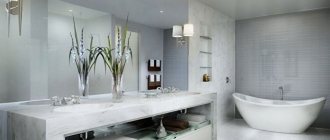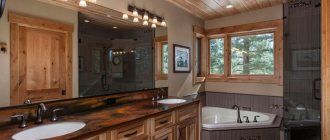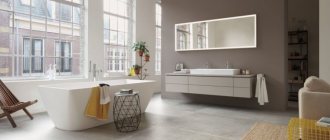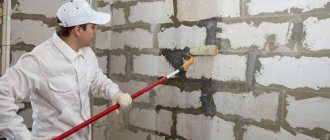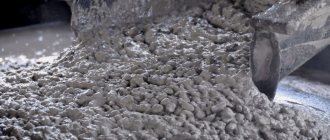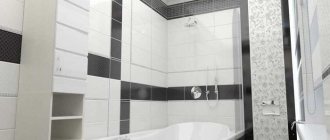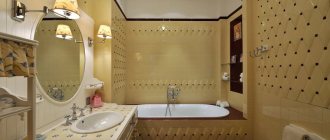To answer the question of whether it is possible to paint tiles in the bathroom, look at the descriptions and characteristics of all modern paint and varnish materials available for sale. There is a special category of coatings used on tiles with different surfaces, including polished, glazed and matte.
Any paint will adhere to matte surfaces; there are characteristic irregularities on it that contribute to the fixation of particles of the coloring material.
But before you start painting tiles in the bathroom, think about whether it is worth doing or not, because usually tiles are laid for beauty, and not to create relief on the walls. The need for such actions is rather explained by the severe wear of the coating, and there is not enough money to replace it.
Painting features
To figure out how to paint tiles in the bathroom, you should first decide for what purpose it will be done. If the coating is worn out, worn down by the soles of shoes, then the need for painting arises to update the appearance and make it more aesthetically pleasing.
The need in this situation is explained by the lack of funds to purchase new tiles and their further installation. But painting is far from permanent when it comes to floor repairs. If the walls are painted, the paintwork will stay on them longer, which is due to the nature of the loads.
Painting tiles in the bathroom is carried out in the following cases:
- Decorating a room, making original patterns, individual fragments or some kind of drawings on plain surfaces.
- Masking defects on surfaces caused by careless use, scratches, chips or other defects.
- Change the decor in the interior if the old decoration is already boring. Moreover, water-based paints can be removed if desired without damaging the ceramic cladding.
Why paint tiles in the bathroom
Traditionally, tiles are considered the best wall and floor coverings for rooms with high humidity. The average lifespan of finishing material is 25 years or more. Naturally, during this time the bathroom interior becomes outdated/boring many times over. The main tasks that painting tiles in a bathroom solve are:
- replacement of existing interior design;
Wall painting to increase the decorative value of the interior. - reducing the budget and labor intensity of repairs;
Removing tiles is considered the most dusty operation of a bathroom overhaul. - cosmetics instead of major repairs in a short time;
- absence of “wet” technologies and work;
- masking tile defects (chips, cracks);
- reduction of finishing time.
Painting work is carried out much faster than laying tiles.
Over time, interiors become boring, and tiles are too expensive to buy collections of them every 5 years to implement fresh design solutions. Therefore, it is easier to apply paints and varnishes to individual areas in fragments or to paint the entire surface in a color of interest to the user.
Floor and wall coverings - mosaics, tiles, porcelain tiles - are subject to restoration.
Possible color options
It is the needs that explain the need to paint ceramic tiles in the bathroom, so first of all, decide for what purposes it will be done:
- Wear of tiles . This is due to the low quality of the tiles, which were purchased from an unreliable manufacturer.
- Interior decoration . One of the reasons for painting ceramics is its decorative decoration, that is, using stencils, apply original patterns and thematic designs if the usual plain colors are already boring. This is a convenient way to make your bath or shower more enjoyable.
- Restoration of the drawing . The surface of a beautiful panel is damaged by careless movement of furniture and especially when installing plumbing equipment. In such situations, nothing good can come of it on your own, so they turn to the services of experienced craftsmen - artists, designers with practice and skills, if they don’t have their own. Regardless of the purpose of performing such work, prepare the surface so that the paint lays down and stays on it for a long time.
How to prepare walls for painting
If, before applying paint, the wall is not cleared of the previous finishing material, then you need to resort to the following actions:
- potholes and deep cracks can be smoothed out with thick sandpaper;
- It is recommended to first level the plaster, cover the cracks with a new layer and rub out the remaining imperfections using sandpaper;
- Whitewash can be washed off with plenty of water, using a sponge;
- mold and fungal spores are removed using special solutions in accordance with the instructions.
Bathroom and showerSource remoo.ru
In beigeSource krovati-i-divany.ru
The old layer of paint can be removed in several ways. For a relatively recently applied layer, you will need a spatula or an angle grinder disc, or a chisel will also work. If the layer is dense enough, then it can be heated with a hair dryer, and then the peeled parts can be removed.
If paint is applied to already finished walls, then the tiles or plastic tiles must first be degreased.
Sea green bathroomSource dekor.delfi.ee
Preparatory stage
Let's figure out how to paint tiles in the bathroom so that the updated coating does not lose its appearance.
Prepare the wall thoroughly. The work consists of applying a special primer, which will help retain subsequent layers of paintwork. First, clean the surface from dust, dirt, plaque and other types of contaminants that are usually present on tiled surfaces, often with the formation of hard deposits.
Choosing tools
To paint walls you will need the following tools and equipment:
- A set of brushes and a roller, it is recommended to have several varieties depending on the size of the pile, length and its hardness.
- Primer, paint or paint kit. It is advisable to choose materials that have good contact with each other, forming a durable, wear-resistant coating.
- Masking tape is a material that is useful for making complex outlines. It is used to seal all surfaces that should not be painted. Having skillful hands and ease of movement, create original patterns and decorations, highlighting certain elements.
- A palette for mixing shades of paint and thus obtaining the desired colors.
- You will also need film or paper; cover the floor so that it is not smeared with paint.
Choosing paint and other materials
When looking for an answer to the question of how to paint bathroom tiles, pay attention to materials with increased resistance to water and household detergents. If this main condition is not met, then the final result will be clearly worse than expected.
The best paints and primers for work in such rooms are materials based on acrylic and epoxy bases.
You can use alkyd, oil and nitro enamels, but these are highly aromatic and harmful substances. This coating looks beautiful, but durability is worth dreaming of; they are not resistant to the aquatic environment if the surface has not been properly prepared.
Acrylic and the same oxide compositions are suitable for finishing due to their unique properties. This is due to high adhesion and the ability to maintain color for a long time. Acrylics always turn out bright and rich, epoxy compounds create shine and shimmer, but when working with such compounds, be careful.
Preparing the surfaces
How to paint tiles on the walls in the bathroom so that they look beautiful for an unlimited period of time? Prepare the surface of the tiled base thoroughly.
The procedure consists of washing and cleaning the seams from dirt. This is done using a special sponge, solvent and other degreasing agents. First, it is washed, thoroughly wiping the seams, then degreased and primed to increase adhesion. No matter how high-quality the paint is, the surface is primed.
Painting tiles - surface preparation
The tiles to be painted must be thoroughly washed with water and detergent and degreased, and large dirt must be removed from the surface. After washing with detergent, rinse with clean water. Silicone fillings must be removed. If you want the seam pattern not to be clearly visible on the plane being repaired, the gaps between the tiles can be filled with putty, but the edges of the tiles must be matte in advance so that they adhere well to them.
Matte and porous tiles (such as terracotta) are easier to paint. Glazed or polished tiles may sometimes require finishing with fine sandpaper. Sanding tiles is also recommended on floors and where the new finish will be affected by high humidity (showers). Very low grit abrasive paper (180-240) is used to matt the surface. The tiles must be free of dust after sanding. The primer is applied in one or two layers.
Coloring
The painting process consists of uniformly applying the coating using a brush and roller. Areas that do not need to be painted along the contour with masking tape are pre-sealed.
If you make a beautiful drawing, then use a stencil or template.
It’s easy to work with these products; stick it on the surface to be decorated and lightly dip a brush or roller into the paint and apply the coating. Do this carefully so as not to go over the edges, evenly distributing the composition over the entire surface.
Plain coloring
There are many options for painting bathroom tiles, depending on personal preferences and the desire to change the interior.
One of them is global - monochromatic painting in any of the shades chosen for a specific design. For example, someone wants to change the environment and choose bright colors: yellow, green, and variations of other tones.
Painting tiles in different colors
The desire to create a special atmosphere is fulfilled by painting the tiles in a variety of colors. It is done in a checkerboard pattern, the combination and combination of shades is thought out. I often want to create a multicolor panel made on any theme.
These include both marine species, animals, and landscapes from tropical countries. To create a karst drawing, contact the services of an artist.
Drawing
An original pattern is a simple and common way to finish a bathroom or shower room over finished tiles. It will cover the surface of the walls, or may partially occupy only part of it. The drawing reflects themes, depending on preferences and personal considerations.
It is important to know! The drawing can be created from scratch or you can use stencils special for this. An outline is created and painted in the desired colors. These can be landscapes with a tropical theme, images of sea creatures, patterns, figures and much more.
Using a stencil
To create exclusive interiors in the bathroom, the use of stencils is practiced. These are convenient devices with the help of which individual paintings and entire compositions are created. For example, having chosen one topic, use many forms.
Decorating tiles
To somehow decorate the bathroom and make staying in it more attractive, decorate the tiles. For example, in an artistic style, seal the joints by creating a shadow effect or using other methods. Emphasize the design with eyeliner, framing, and retouching.
We also recommend watching - Characteristics and design of marble tiles for the bathroom
3d effect
There is an original drawing technology with a 3D effect. To paint such a picture, you need to have experience and skills. Look at a lot of solutions on thematic resources, collect relevant ones and try to turn them into reality. But in order for the effect to be maximum and less of your time spent, it is recommended to contact an artist.
Methods for creating a panel or ornament
An original decoration of the bathroom will be a panel or ornament made by a professional hand of a craftsman. To create such a masterpiece, use the help of a specialist, he will make your every desire come true.
The composition can be small or cover the entire wall, depending on individual preferences. For example, to realize a detailed landscape of the embankment. Ornaments can also be configured.
Materials and tools
To work you will need:
- primer;
- paint for tiles, selected taking into account the recommendations;
- roller;
- brushes of different sizes;
- liquid detergent (for example, Fairy);
- masking tape;
- sponge;
- polyethylene film;
- clean rags;
- vinegar or any alcohol-containing liquid;
- sandpaper;
- water-based varnish (it will not turn yellow over the years, unlike regular varnish);
- a stencil or template for applying the pattern (if one is planned).
Reviews about paints
According to reviews, the compositions have the following properties:
- Flügger Flutex 10 is a thick matte paint. It has a noticeable smell, not particularly strong. It's easy to apply, doesn't drip, and doesn't require much leveling. The Flutex coating is not bad - applied with a brush. Full coverage can be achieved in just 2-3 coats. Nothing special? The old bathroom disappeared under 5-6 coats of V33 roller painted. Not a bad result.
Photo of a painted wall – matte white - V33 for tiles is a two-component product - the contents must be poured into a container, then mixed thoroughly. The additional component that guarantees the properties of the product turned out to be problematic, so it is necessary - its smell is unpleasant, spicy. V33 is more liquid, it seems that it “flows” along the wall. After applying two coats, the walls looked much better, although they still needed bleaching. Experience, the right tools, and work technique will be decisive!
Photo of a painted wall – satin white with shine
Photo. 3 coats of V33 applied
Photo. V33 Layer Count Comparison
Is it possible to paint tiles with paint?
Do you need special products to paint tiles in the kitchen or bathroom, or is regular wall paint suitable? Definitely required. This is due to 2 factors:
- the specifics of the surface (different types of ceramics);
- rather difficult conditions existing in the bathroom, kitchen - humidity, high temperature, splashes of grease.
Surfaces finished with plaster or covered with ceramic tiles are different - they have different structures, they react differently to painting:
- when painting a plastered wall, the paint freely penetrates into the microscopic pores of the plaster, bonding with its base;
- Ceramic tiles are dense, compact, smooth, so paint has no chance to penetrate its structure and does not adhere well to the surface, so it is necessary to use special products.
When planning to paint tiles in the kitchen or bathroom, you need to remember certain conditions that exist in these rooms. The paint must have the following properties:
- adapted to prolonged contact with moist air, water;
- resistant to cleaning and mechanical damage;
- resistant to detergents, so you can wash walls and floors without fear of damaging the coating.
Photos of work: after and before painting
Is it possible to paint the tiles or is it better to knock them down and glue a new one? If the tiles are in good condition, there is no need to replace them. Painting will update the interior, change the color - quickly and inexpensively.
How many layers should I apply?
You should use the information contained in the product instructions and your own wishes regarding color intensity. Between applying layers, you need to allow a drying interval of 12-48 hours (depending on the manufacturer's recommendations).
New paintwork takes much longer to cure:
- mechanical resistance is achieved after a few days;
- chemical resistance – after about a week;
- full functional properties – in a month!
You should not use the room for the first 3-4 days; you need to treat painted surfaces with care for the next few days. You must be careful not to stain the painted surface or splash it with water.

